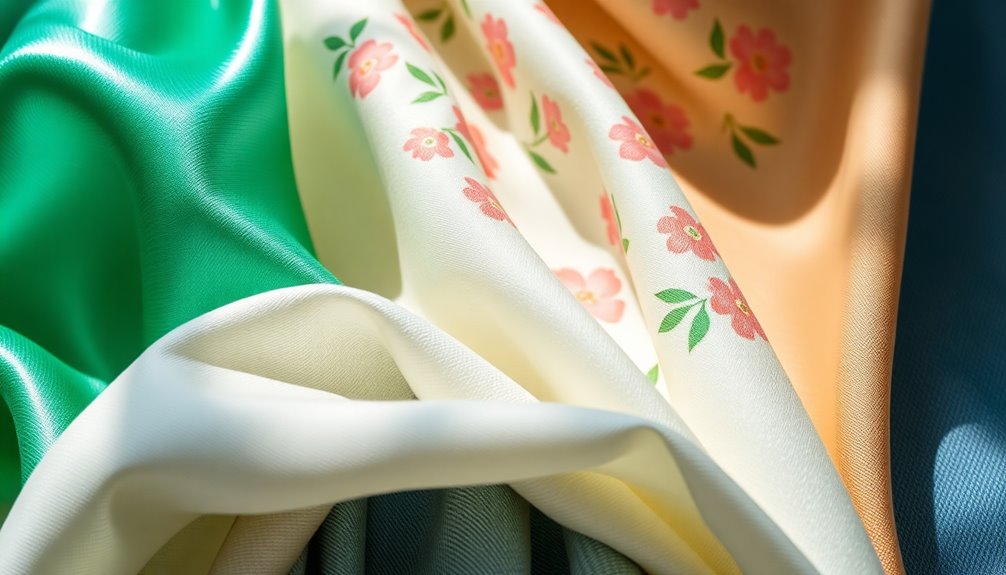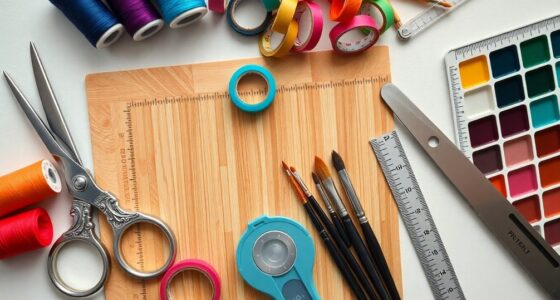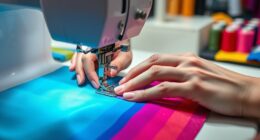When choosing fabric for your projects, first consider your project’s purpose—functional or decorative. Evaluate the fabric’s look and feel by touching it and checking colors in natural light. Pay attention to weight and drape; lighter fabrics flow, while heavier ones hold structure. Assess flexibility for comfort and verify you know the care instructions to maintain quality. With these insights, you’ll be well-equipped to make the right choice. More tips are just ahead. Additionally, consider the longevity of the fabric, as some materials may wear down more quickly than others. It’s also essential to familiarize yourself with fabric cleaning best practices to ensure your creations remain vibrant and intact over time. By selecting the right fabric and understanding how to care for it, you’ll enhance not only the appearance of your project but also its durability.
Key Takeaways
- Determine the project's purpose to select functional or decorative fabrics, considering durability and comfort based on intended use.
- Evaluate the aesthetic qualities of the fabric, including drape and texture, to achieve the desired look for your project.
- Consider the fabric weight and drape; lighter fabrics flow while heavier ones provide structure, impacting the final design.
- Assess the flexibility and stretch of the fabric to ensure it aligns with the project's comfort and fit requirements.
- Review fabric care requirements, including washing and drying instructions, to maintain quality and longevity throughout the fabric's use.
Understand the Purpose of Your Project
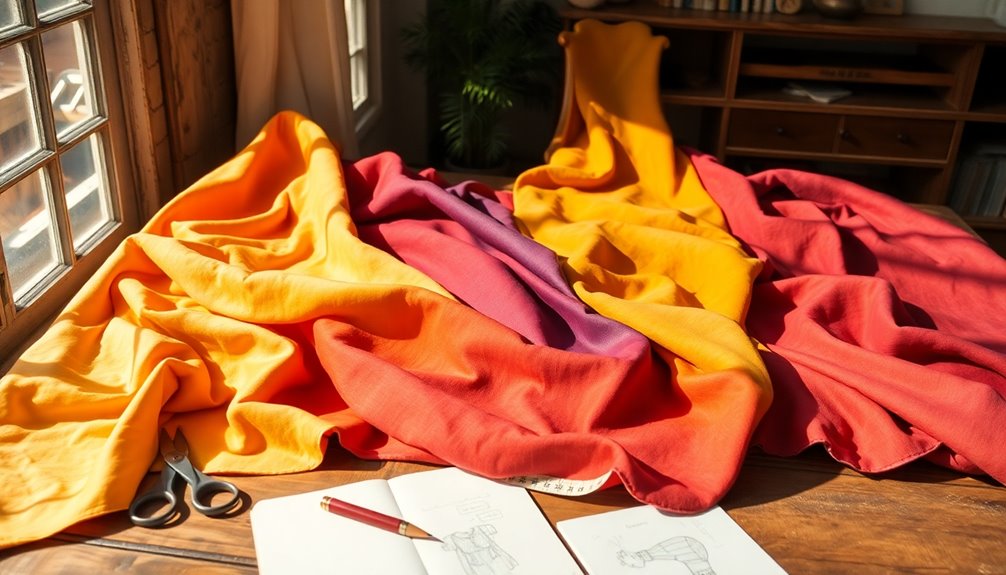
When you understand the purpose of your project, it makes choosing the right fabric much easier.
Defining whether your project is functional or decorative streamlines your fabric choice considerably. For practical items like handbags, opt for durable fabrics such as canvas or denim. If you're making decorative items like throw cushions, softer materials like cotton or linen work best.
Consider the climate too; lightweight fabrics suit summer clothing while heavier options keep you warm in winter. For children's garments, prioritize safety by selecting fabrics with certifications free from harmful chemicals. Always assess specific requirements, like water-repellent properties for outdoor items or flame retardant characteristics for commercial environments, to guarantee your fabric choices enhance functionality. Additionally, understanding the importance of skin safety in materials can help in choosing fabrics that are gentle on the skin, especially for projects involving clothing or personal items.
Evaluate the Look and Feel of the Fabric
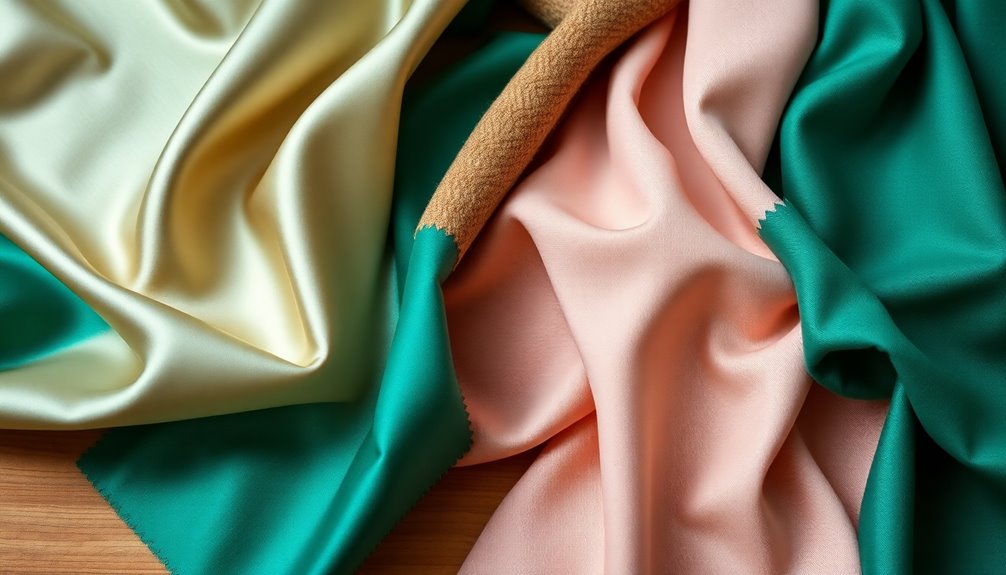
How do you want your project to look and feel? The aesthetic hinges on the fabric's drape and texture. Fabrics like silk and rayon create flowing garments, while stiffer options like canvas maintain structure. Texture matters too; soft cotton offers comfort, while burlap provides a more utilitarian vibe.
To guarantee your vision aligns, always evaluate fabric colors in natural light. Here's a quick comparison of different types of fabric:
| Fabric Type | Look and Feel |
|---|---|
| Silk/Rayon | Flowing, luxurious |
| Cotton | Soft, comfortable |
| Canvas/Burlap | Sturdy, utilitarian |
Choose wisely, as the right fabric transforms your project from ordinary to extraordinary! Additionally, consider how color theory can enhance your fabric selection and overall design.
Consider Fabric Weight and Drape
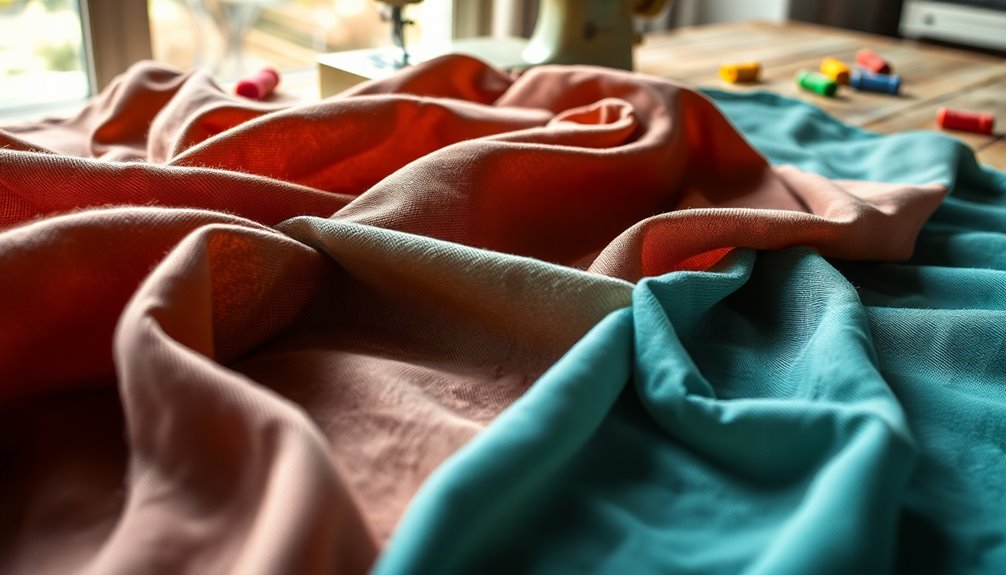
Understanding fabric weight and drape is essential to achieving your desired look and functionality in any project.
Fabric weight markedly influences drape; lighter fabrics like chiffon flow gracefully, while heavier options such as canvas maintain structure.
When you're selecting fabric, think about your project's purpose. If you need garments that allow movement, opt for fabrics with a soft drape, like silk or rayon. For tailored items, choose stiffer materials that hold their shape well.
Fabric weight is typically measured in grams per square meter (GSM), with lighter fabrics under 150 GSM and heavier ones over 300 GSM.
To gauge drape, let the fabric fall naturally over your hand or arm, revealing how it will work in your design.
Assess Flexibility and Stretch

Fabric weight and drape are important, but equally essential is evaluating a fabric's flexibility and stretch. Understanding these characteristics helps you choose the right material for your project.
Here are some key points to take into account:
- Stretch Types: Fabrics like jersey or spandex are designed to stretch, perfect for fitted garments.
- Testing: Gently pull the fabric in both directions; good stretch will return to its original shape.
- Project Needs: Stretchy fabrics are ideal for activewear, while non-stretch fabrics suit tailored pieces.
- Matching: Verify the fabric's stretch aligns with your design; using a stretch fabric for fitted designs enhances comfort.
Review Fabric Care Requirements
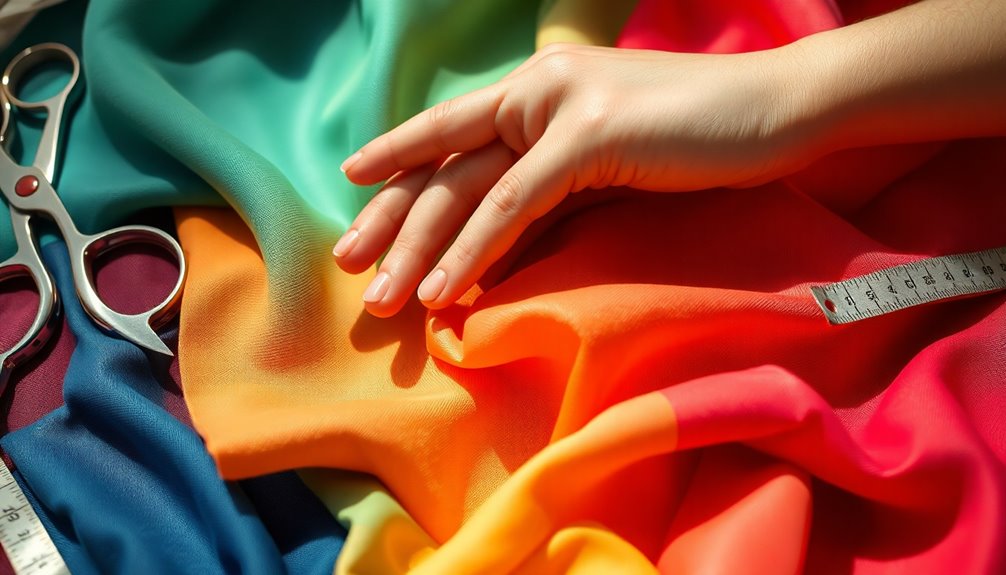
When selecting a fabric, it's vital to keep its care requirements in mind, as these can greatly impact your project's longevity and appearance.
Different fabrics come with varying washing needs; for example, cotton is usually machine washable, while silk often requires hand washing or dry cleaning. Understanding shrinkage potential is imperative—pre-washing cotton before sewing can prevent size discrepancies in your finished garments.
Some fabrics, like wool, may need special care to avoid felting, while those labeled as "water-repellent" or "stain-resistant" require specific cleaning instructions.
Always check the care label before purchasing to guarantee you know the washing, drying, and ironing recommendations, helping you maintain the fabric's quality for years to come.
Match Fabric Choice to Skill Level
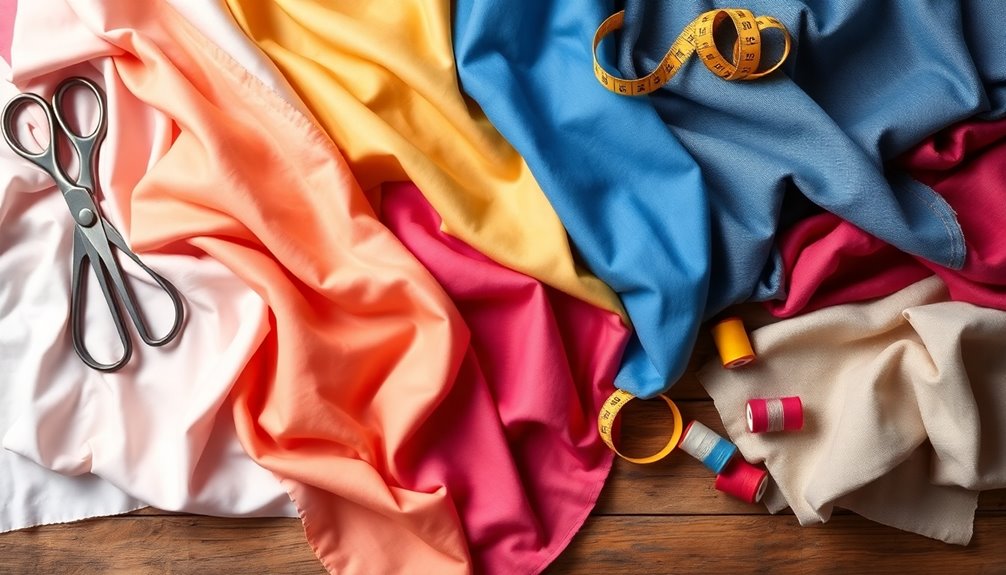
When you're starting out, it's best to stick with beginner-friendly fabrics like cotton or canvas, which make sewing less intimidating.
As you gain confidence, you can try your hand at more advanced fabric techniques with materials like knits or silks.
Matching your fabric choice to your skill level not only eases frustration but also enhances your overall sewing experience.
Beginner-Friendly Fabrics
Choosing the right fabric can make all the difference in your sewing journey, especially if you're just starting out.
When you're choosing a fabric, opt for beginner-friendly fabrics that are easy to sew and handle. Here are some great options:
- Cotton: Durable and comes in countless patterns and colors.
- Canvas: Sturdy, lightweight, and easy to clean; perfect for many projects.
- Polyester: Affordable and less prone to wrinkling, making it a practical choice.
- Stretch Jersey: Ideal for fitted garments, especially when using a zig-zag stitch.
Advanced Fabric Techniques
As you gain confidence in your sewing skills, exploring advanced fabric techniques can elevate your projects to new heights.
While beginners thrive with durable materials like cotton, you can venture into high-quality materials such as silk or faux fur. Understanding the stretch of fabrics is essential; for instance, using zig-zag stitches on stretch fabric like jersey helps maintain its shape.
Intermediate sewists can experiment with knits but should master an overlocker to avoid warping. For advanced techniques, consider using a walking foot with slippery fabrics like satin to guarantee even feeding.
Explore Sustainable Fabric Options
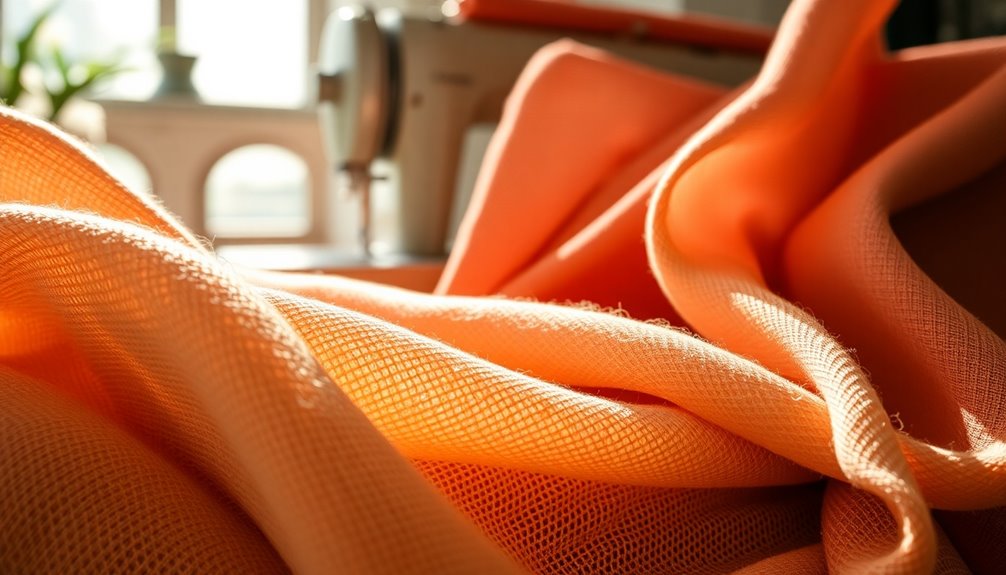
How can you make a positive impact on the environment while working on your projects? By choosing sustainable fabrics, you can create beautiful pieces while being eco-conscious.
Here are some options to take into account:
- Organic Cotton: GOTS-certified, it's grown without harmful chemicals.
- Tencel: Made from sustainably sourced wood pulp, it's biodegradable and soft.
- Hemp: Requires minimal water and pesticides, making it a durable choice.
- Recycled Polyester: Reduces plastic waste, turning it into new fabric.
Opting for these eco-friendly fabrics not only supports a circular economy but also guarantees your projects last longer, saving you money in the long run.
Frequently Asked Questions
How Do I Choose the Right Amount of Fabric?
To choose the right amount of fabric, start by checking your pattern's requirements for yardage based on size and style.
If you're not using a pattern, measure your project's dimensions and add extra for hems and seams, typically 1/4 to 1/2 yard.
Don't forget to take into account fabric width; it varies.
Finally, it's smart to buy about 10% more fabric to cover any mistakes or adjustments during your project.
What Are the 4 Things to Consider When Choosing Fabric?
When choosing fabric, think of it as picking the right brush for your artistic canvas.
First, consider the project's purpose—will it endure wear or flow with grace?
Next, assess the fabric's weight and drape; heavier fabrics hold structure, while lighter ones dance.
Don't forget care requirements—choose something that fits your lifestyle.
Finally, guarantee the fabric's aesthetic aligns with your vision, creating a harmonious masterpiece that reflects your creativity.
How to Know What Kind of Fabric to Use?
To know what kind of fabric to use, first assess your project's purpose.
If it's functional, opt for durable fabrics like canvas. For decorative items, lighter fabrics work best.
Next, consider the weight and drape; heavier fabrics add structure, while lighter ones flow.
Don't forget to check the stretch and care requirements to match your lifestyle.
Finally, research fiber content and weave types to guarantee the fabric suits your design vision.
Which Fabric Is Best for My Sewing Project?
Picture yourself wrapped in a cozy, soft blanket or donning a flowy, elegant dress.
To choose the best fabric for your sewing project, think about its purpose. For sturdy bags, go for canvas; for graceful gowns, select chiffon.
Consider weight and stretch, too—lightweight fabrics drape beautifully, while stretchy ones fit like a glove.
Finally, match your skill level with the fabric: cotton's forgiving for beginners, while satin challenges the more experienced.
Conclusion
Choosing the right fabric is like picking the perfect paint for a masterpiece; it sets the tone for your entire project. By understanding your project's purpose and the fabric's qualities, you can weave together beauty and functionality. Remember, the right fabric will not only bring your vision to life but also dance gracefully through your hands as you create. So go ahead, let your imagination soar, and embrace the wonderful world of textiles waiting for you!
